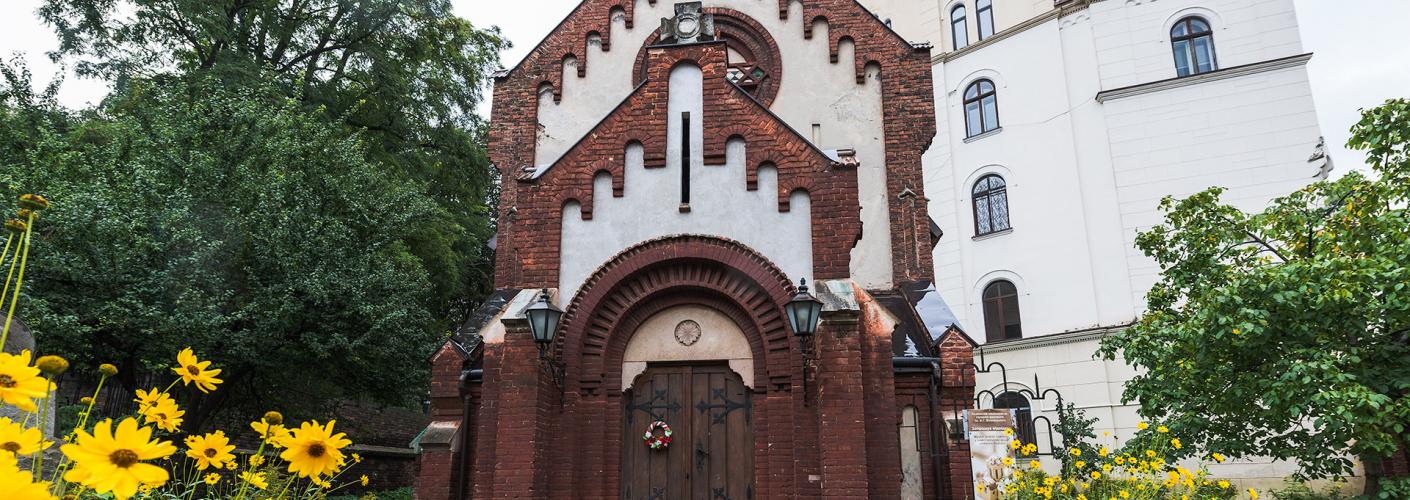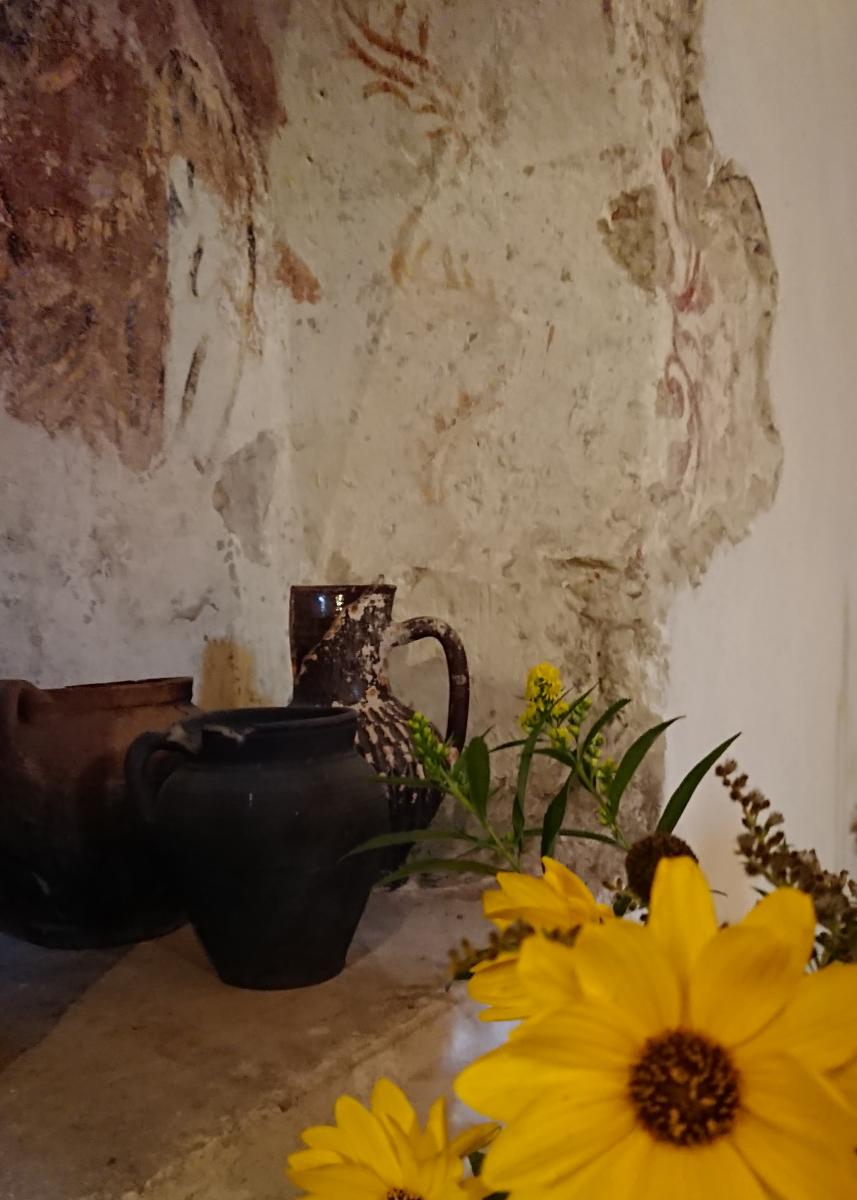
Інформація
Понеділок: вихідний
Вівторок
11:00 – 16:00
Каса до 15:30
Середа – Неділя
10:00 – 17:00
Каса до 16:30
Туристичні групи (подорожі груп туристів, організовані туристичним підприємством, іншим підприємством, установою чи організацією) з наповненістю не менше 10 осіб можуть відвідати експозицію музею з вівторка по неділю, за умови, що візит буде сплановано не пізніше, ніж за 24 години до орієнтовної години приїзду.
Замовити екскурсії можна за номером телефону
+38 098 557 67 90.
Вартість вхідних квитків:
- для дорослих: 100 грн
- для дітей і пенсіонерів: 50 грн
- для студентів: 80 грн
Вартість сімейних квитків:
- 1 дорослий + 1 або 2 дитини: 150 грн
- 2 дорослих + 1 або 2 дитини: 250 грн
Вартість екскурсій для групи до 20 осіб:
- для дорослих: 200 грн
- для дітей і пенсіонерів: 100 грн
- для студентів: 150 грн
+38 098 557 67 90
Музей Храм Івана Хрестителя
Існує декілька легенд і наукових версій історії побудови храму Івана Хрестителя, в якому розташований Музей. За однією з них, храм міг бути збудований ще на початку ХІІІ ст. – у 1201 році князем Романом Мстиславичем на честь народження сина Данила Романовича, церковне ім’я якого – Іван (про це свідчить грамота Папи римського Інокентія ІV від 1246 року). Не виключено, що храм може бути першою кам’яною спорудою міста Львова. Також є версія про побудову храму після одруження князя Лева Даниловича з дочкою угорського короля Бели IV – Констанцією у 1247 році. Побутує навіть легенда про поховання тут Констанції.

Перша письмова згадка про храм відноситься до 1371 року. До середини XIV ст. він очолював головну торгівельну площу княжого Львова – Старий Ринок.
Споруда неодноразово перебудовувалась. З XVI ст. маємо зафіксовану згадку про бічні каплиці. Перебудови та реставраційні роботи проводились у 1650, 1836, 1855 та 1869 роках, а у 1883 дах покрили гонтою. У 1887 році завершено реставрацію будівлі за проектом архітектора Юліана Захарієвича. З 1978 по 1984 роки у храмі проводились архітектурні дослідження та реставраційні роботи під керівництвом Івана Могитича. Частково були залишені пізніші елементи перебудови і нашарування.

У радянський період будівля храму належала лікарні, що розташована поруч, тут облаштували господарські приміщення. А 1993 року в храмі Івана Хрестителя відкрито Музей найдавніших пам’яток Львова у складі Львівської картинної галереї. Тепер експозиція музею формується з тематичних виставок, які стосуються історії давнього Львова та робіт сакрального характеру. Увагу відвідувачів привертають фрагменти стінопису, що були відкриті в процесі реставрації, їх датування дискусійне від XIII до XVI ст.
До 1939 року служби в костелі відбувались раз на рік – на Різдво Івана Хрестителя. З 2009 року богослужіння УГКЦ в храмі проводяться щонеділі та у свята.
St. John the Baptist Church
It is difficult to imagine Lviv without sacred buildings, which have contributed to its unique image. The city's architectural colors have evolved over time into a palette of styles that can be seen in the foundation walls of an ancient temple, the window of a stone house, or in a memorial chapel.
St. John the Baptist Church, now a museum branch of Borys Voznytskyі Lviv National Art Gallery, is one of the oldest churches in Lviv.
The architectural monument of the 12th–20th centuries sparks endless debates, especially, about the history of the sanctuary’s foundation.
According to one version, Prince Roman Mstyslavovych built the church in 1201 to commemorate the birth of his son, Daniel of Galicia, whose patron was St. John the Baptist. Another version claims that it was the foundation of Jacek Odrowaz, the canonized Polish saint and Dominican legate in Kyiv, who in 1234 visited the area where Lviv later appeared.
In accordance with the legend, after Prince Leo married Constance in 1247, the church became a family shrine, where the Hungarian princess was later buried. Some scientists trace a connection between the building up of the church and Lviv’s Armenian community in the years of 1363 and 1371. They claim that the first written mention of the shrine coincides with the completion of that period.
Archaeological excavations prove that people have lived near the temple since the 12th century. It is also believed that King Daniel founded the city of Lviv in the middle of the 13th century on the basis of that settlement at the foot of Castle Hill. By the 14th century, a shopping area in front of the temple was known as the "Old Rynok", and it was the centre of city life.
Unfortunately, due to the relocation of the centre of Lviv to the so-called "Gothic" city and the formation of a new market square, the church lost its significance and came into decay. In addition, the building was destroyed by fires (including those in 1623 and 1799) and wars, after which it underwent reconstruction. Thus, the northern and southern wings were bricked up in the 17th–18th centuries, and at the end of the 19th century the building was given neo-Romanesque features by the famous Lviv architect Julian Zachariewicz.
During Polish and Austrian rule, services in the devastated church were held only once a year, on the Nativity of St. John the Baptist.
In the Soviet period, the building belonged to a nearby hospital. Thus, the utility rooms were arranged there. A new stage in the life of the ancient church began in 1993, with the opening of the Museum of Lviv’s Ancient Relics as part of the Lviv Art Gallery. Today the museum's exposition consists of thematic exhibitions and works of sacred art. The fragments of wall frescoes, which were discovered during the restoration, attract visitors’ attention. Scientists still debate over their dating—from the 13th to the 16th centuries.
Ancient but full of life, St. John the Baptist Church is filled with legends. It testifies to the spiritual invincibility of Ukrainians, the ability to overcome hardships, and the connection of past, present, and future.
Muzeum „Kościół Jana Chrzciciela”
Istnieje kilka legend i wersji naukowych historii budownictwa kościoła Jana Chrzciciela, w którym mieści się Muzeum. Według jednego z nich świątynia mogła być zbudowana już na początku XIII wieku – w 1201 roku przez księcia Romana Mścisławowicza na cześć narodzin jego syna Danyła Romanowicza, któremu nadano imię kościelne Iwan (świadczy o tym list papieża Innocentego IV z 1246 roku). Niewykluczone, że świątynia może być pierwszą kamienną budowlą miasta Lwowa. Istnieje także wersja mówiąca o budowie świątyni po ślubie księcia Lwa Daniłowicza z Konstancją, córką króla węgierskiego Beli IV, w roku 1247. Istnieje nawet legenda o pochówku Konstancji w tym miejscu.
Pierwsza pisemna wzmianka o świątyni pochodzi z 1371 roku. Do połowy XIV wieku kościół był głównym gmachem ówczesnej handlowej dzielnicy książęcego Lwowa – Starego Rynku. Budynek był niejednokrotnie przebudowywany. Od XVI wieku mamy odnotowaną wzmiankę o kaplicach bocznych. Prace odbudowy i renowacji prowadzono w latach 1650, 1836, 1855 i 1869, a w 1883 roku dach pokryto gontem. W 1887 roku zakończono renowację budowli według projektu architekta Juliana Zacharewicza. W latach 1978‒1984 w świątyni prowadzono badania architektoniczne i prace restauratorskie pod kierownictwem Iwana Mohytycza. Częściowo pozostawiono późniejsze elementy przebudowy i nawarstwiania.
W okresie sowieckim budynek kościoła należał do znajdującego się w pobliżu szpitala, wybudowano tu pomieszczenia gospodarcze. Natomiast w 1993 roku w kościele Iwana Chrzciciela otwarto Muzeum Najstarszych Zabytków Lwowa w składzie Lwowskiej Galerii Sztuki. Obecnie ekspozycja muzeum – to wystawy tematyczne, które związane są z historią starożytnego Lwowa oraz dziełami o charakterze sakralnym. Zwiedzający zwracają uwagę na fragmenty malowideł ściennych odkrytych podczas renowacji, ich datowanie od XIII po XVI wieku jest dyskusyjne.
Do 1939 roku msze odbywały się raz w roku – w Boże Narodzenie Jana Chrzciciela. Od 2009 roku w kościele w każdą niedzielę i święta odprawiane są msze UGKC.